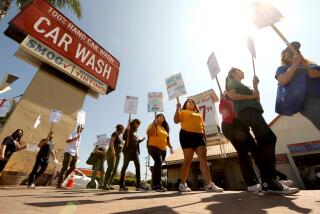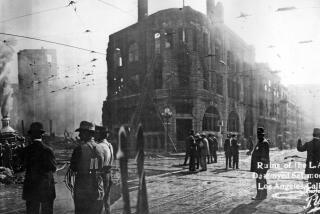The Times on labor
The Times has not been organized labor’s best friend over the years, nor has labor always been kind to The Times. In the earliest decades of this city and its newspaper, The Times furiously defended Los Angeles as an open shop, establishing it as a business-friendly counterpart to unionized San Francisco. When the American Railway Union launched its historic strike in 1894, The Times “stood fast, stood firm, stood true,” its city editor recalled a few years later, “for law and order.” In those days, anyone who read The Times knew that “law and order” meant opposition to labor and all who supported it.
Labor exacted its revenge in 1910, when union activists planted sticks of dynamite in an alley next to The Times building. The blast killed 20 employees, and although labor denied involvement, The Times did not for a moment doubt who was responsible. The next day it pointed the finger at “unionite murderers.” Its vitriol was vindicated when the perpetrators confessed.
Over the years, the animus between The Times and labor subsided, if ever so gradually. In the 1950s, Publisher Norman Chandler was able to boast that he had never once negotiated with a union leader. In 1970, the paper cautioned state employees against striking but acknowledged the legitimacy of their worries about then-Gov. Ronald Reagan. By 1986, it was calling for cooperation between labor and management as the only “certain way to build a more prosperous economic future benefiting all Americans.” And in 2006, this page featured an editorial under the headline “Safe, secure and unionized,” words our forebears would never have dreamed of putting into print. Today, The Times regards organized labor respectfully, if not always enthusiastically, and appreciates that unions are an established and animating fact of this city’s political and civic life.
And so, on this Labor Day, we revisit a tradition of excerpting editorials from these pages in order to reflect on this newspaper’s long and sometimes troubled relationship with labor. We do so with acknowledgment that the past often has been heated, but with the hope that the future continues our cooling trend.
Oct. 2, 1910
To the owners, editors and managers of The Times, nothing connected with the explosion is so deeply distressing as the suffering which the inhumanity of the unionite brutes has caused to the widows and orphans. Women who, on Friday evening, kissed their husbands good by as the latter left for their night’s work, are, in some cases, denied even the sight of the men, for their bodies remain amid the ruins. Never again will the children climb “the envied knees to share,” for they have been deprived, by the unionite murderers, of that blessed privilege.
Nothing can palliate this awful deed, so terrible in its effects, and we have only horror for the assassins who have stricken down the heads of a number of families, happy until yesterday. Terrible outrages have been performed in the name of labor unionism heretofore, but we cannot recall one of so heart-rending a character as this. It seemed, until yesterday, impossible to believe that men could go to such extremes, could resort to such inhuman tactics, could wantonly bring sorrow upon innocent women and children, merely with the idea of obtaining revenge against The Times.
Oct. 3, 1919
The mania to organize the whole world into unions goes on apace. Every day some hitherto unheard-of class of the world’s population jazzes into the news with the announcement that it has organized itself and has applied to Sam Gompers for a charter. . . . When this universal unionization is accomplished it will be interesting to note the effect of that popular diversion known as the “sympathetic strike.”
Let us suppose, for instance, that the potato peelers’ union in a big hotel gets sick and tired some day at the very sight of spuds and decides to strike. And suppose things do not go very well with the strike, and the walking delegate of the potato peelers decides to call out other unions in sympathy, what happens then?
First of all, the union that has in charge the work of picking the hairs out of the hash throws down its tools, then the dishwashers’ union quits, then the chambermaids, the waiters, the clerks and the barbers and manicures. Promptly, then, the managers’ union and the proprietors’ union strike, and finally the guests’ union up and strikes to a man.
All that remains to be done after that is for the burglars’ union and the yeggmen’s union to step in and finish the job.
Aug. 6, 1922:
Both the railroad strike and the coal strike have suddenly taken on an aspect of increased violence. . . . By hurling bombs and trying to beat men to death they have created an unassailable position against themselves. After seeing their strike-breakers endure this danger, suffer these outrages, how could the railroads, in common decency, deny them rights of preferment over the men who are bombing them?
It requires high courage, determination and unfaltering principle for any workman to continue working in the face of this storm of violence. Even higher courage than to fight in a battle. No soldier can leave a battle. These men can leave any time their courage falters. They stick it out voluntarily because they have faith in the square dealing and honor of the railroads for whom they are working under such trials and dangers. . . .
The bomb-throwers are proving the falsity of their case. Every bullet and every blow is an argument against them.
June 22, 1945
[T]he law should forbid the expulsion of anybody from a union except on reasonable grounds. In recent cases union members have been expelled and deprived of a livelihood for testifying in court against the union, for refusing to pay political assessments and for writing a letter to a newspaper criticizing a union -- an outrageous situation. . . . Regulation of the excesses of unionism is inevitable and the unions will be better off to accept mild regulation now than to have stiff regulation imposed later.
March 29, 1963
As this is written 300 photoengravers are giving the dying New York newspaper strike a few more gasps of life. The printers, who started the strike 3½ months ago, have been ready to go back to work.
The photoengravers’ gesture is a punch line that summarizes the whole story of the demoralizing and costly strike: the tiny well-placed minority can paralyze a great industry and deprive the metropolis of an essential service. Moreover, the tiny minority can do this as long as it pleases. . . .
The Constitution forbids government -- government at any level -- from suspending a newspaper. But a small union can do it. Obviously, a small union has more power than the government.
Jan. 29, 1970
Because of dissatisfaction over Gov. Reagan’s cut and squeeze budgetary policies, the California State Employees Assn. has stricken from its constitution a 10-year-old no-strike pledge. . . . That is an unfortunate situation which demeans the stature of state employees. . . .
The Times applauds the decision of three groups of state employees -- the California Highway Patrol, forest fire fighters and fish and game wardens -- who have assured Gov. Reagan that they will not strike under any circumstances.
We commend that stand to all other government employees. . . .
They may have legitimate grievances, but it should be obvious to all that staging a strike could only harm their cause in the eyes of the taxpaying public and would win them no friends in the Legislature.
Sept. 1, 1986
These are not particularly happy days for organized labor in the United States. . . .
Labor has caused some of its own problems through occasional excessive demands in a declining economy and isolated instances of corruption within leadership ranks. But the perception that the nation’s economic woes are rooted solely in high wages is unfair and misleading. Labor’s record of wage and benefit concessions, and its lack of strikes, during the recession demonstrates the unions’ willingness to work with business to overcome common economic misfortune. . . .
There is only one certain way to build a more prosperous economic future benefiting all Americans: for labor and management to work together, in partnership with a national government that is willing to safeguard the traditional rights of American working men and women.
April 12, 2006
A business owner’s decision to recognize a labor union is almost always a private matter. But if those employees happen to be responsible for the safety and security of the tens of thousands of people who daily go to work or do business in or near high-rise office towers, then that decision is important to all of us -- and Mayor Antonio Villaraigosa’s intervention is justified. That’s the case with real estate mogul Robert Maguire’s decision, announced Tuesday, to fund a training program and begin contract talks with the security officers who guard his properties. . . .
Union organizers, of course, hope that after Maguire’s moves, other owners will sign on with alacrity. They want the county’s estimated 10,000-plus security officers to have better pay and benefits, and they want to return the workers, mostly African Americans, to the ranks of immigrant-dominated organized labor. That’s for labor and management to work out. But safety and security are matters that concern all of us, and Maguire’s move -- with the mayor’s help, and with some follow-up by other high-rise owners -- means we all may soon be a little more secure.
More to Read
A cure for the common opinion
Get thought-provoking perspectives with our weekly newsletter.
You may occasionally receive promotional content from the Los Angeles Times.










